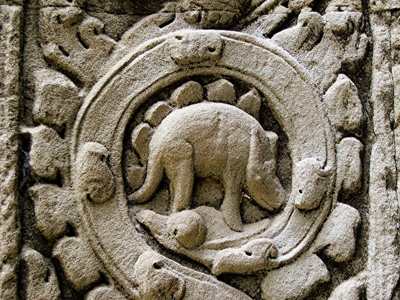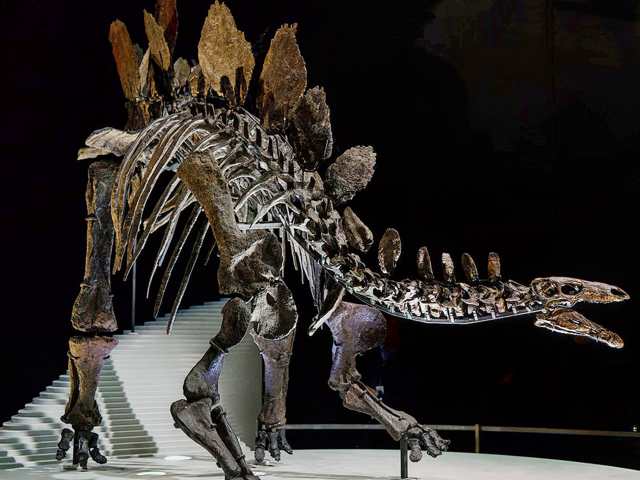Stegosaurus in Cambodia? Dinosaur of Ta Prohm
Dinosaur of Ta Prohm: Behold this captivating relief adorning the grand Khmer temple of Angkor Wat in Cambodia. It has stirred the curiosity of scientists and paleontologists worldwide due to its uncanny resemblance to a prehistoric Stegosaurus, a species supposedly extinct for 65 million years, according to evolutionists.
The question arises: How can we explain this intriguing depiction?
The mesmerizing jungle temples of Cambodia trace their roots back to the Khmer civilization, flourishing from the eighth to the fourteenth century A.D. Among the eminent monarchs and builders of this empire, Jayavarman VII stands out as one of the greatest. Crowned supreme king in 1181, he left a lasting legacy, including the construction of the exquisite temple monastery Ta Prohm in honor of his mother, completed in 1186. Explored by Portuguese adventurers and Catholic missionaries in the 16th century, these awe-inspiring temples underwent restoration in the 19th and 20th centuries. Notably, Ta Prohm, retaining its natural state, emerged as one of the most picturesque.
The enigmatic image in question likely dates back to around 1186, coinciding with the construction of Ta Prohm. While some scientists suggest it might represent a rhinoceros or another large mammal, a faction firmly contends that it undeniably portrays a Stegosaurus. Positioned on a wall adorned with reliefs depicting commonplace scenes in Cambodia—such as large oxen, farmers toiling, and meditating Buddhist monks—the inclusion of a Stegosaurus suggests a curious proposition: Was the Stegosaurus a familiar sight in medieval Cambodia?
This discovery prompts us to reconsider the conventional timeline of dinosaur extinction proposed by evolutionists. Could it be that dinosaurs persisted longer than believed? The presence of a lifelike Stegosaurus in the relief raises intriguing questions about the experiences of those who crafted it—did they encounter a living Stegosaurus, challenging our understanding of prehistoric timelines? The mystery deepens, inviting us to explore the intersection of ancient civilizations and the remnants of a prehistoric world.

Stegosaurus
Unveiling the mystique surrounding the Stegosaurus, a colossal dinosaur that has transcended the annals of time, we delve into a captivating chapter in the history of paleontology and archaeology. Among the myriad enigmas of prehistoric life, the Stegosaurus emerges as a charismatic giant, captivating the imagination of scientists and enthusiasts alike. Recently, an unexpected revelation emerged from the ancient walls of the Khmer temple of Angkor Wat in Cambodia, a testament to the intricate interplay between history and paleontology—the “Dinosaur of Ta Prohm.”
Nestled within the ornate reliefs adorning the temple, this Stegosaurus depiction has sparked fervent discussions within scientific circles. The conventional narrative places the extinction of dinosaurs around 65 million years ago, a timeline that seemingly clashes with the existence of a Stegosaurus in medieval Cambodia. The resplendent jungle temples, crafted by the Khmer civilization between the eighth and fourteenth centuries A.D., stand as silent witnesses to an era where myth and reality intertwine. Notably, the temple monastery Ta Prohm, built in 1186 by the visionary monarch Jayavarman VII, harbors the mysterious Stegosaurus image on its ancient walls.
As the focal point of scholarly scrutiny, the Stegosaurus of Ta Prohm challenges established notions of dinosaur extinction. While some scientists propose alternative explanations, citing the possibility of the depiction representing a rhinoceros or another large mammal, a steadfast faction contends that the image unequivocally mirrors the distinctive features of a Stegosaurus. This captivating revelation prompts us to reconsider the conventional timeline and question whether these majestic creatures persisted in our world longer than previously surmised.
Ta Prohm, frozen in time and left in its natural state, offers a unique window into medieval Cambodia, where everyday scenes of farmers, Buddhist monks, and the enigmatic Stegosaurus coexist on the temple walls. This cohabitation of seemingly disparate elements prompts us to ponder the intricacies of cultural exchange, the intersection of mythology and reality, and the timeless allure of these colossal creatures. The juxtaposition of the Dinosaur of Ta Prohm with commonplace scenes suggests a fascinating integration of the prehistoric into the everyday, challenging our perceptions of the Khmer civilization’s encounters with the natural world.
Intriguingly, this archaeological revelation beckons us to reassess the broader narrative of dinosaur extinction. Could it be that remnants of these colossal beings persisted in remote corners of the world, evading conventional timelines? The Stegosaurus of Ta Prohm encourages us to view history through a nuanced lens, where the unexpected and the extraordinary coalesce to rewrite our understanding of the Earth’s ancient inhabitants.
In conclusion, the Stegosaurus, once thought to have faded into oblivion millions of years ago, now stands resilient in the carved stones of Ta Prohm, Cambodia. This archaeological anomaly prompts us to question established timelines, offering a glimpse into a world where dinosaurs and medieval civilizations intersected. As we navigate the corridors of time, the Dinosaur of Ta Prohm invites us to reconsider the boundaries between myth and reality, challenging us to embrace the ever-evolving tapestry of Earth’s history.

